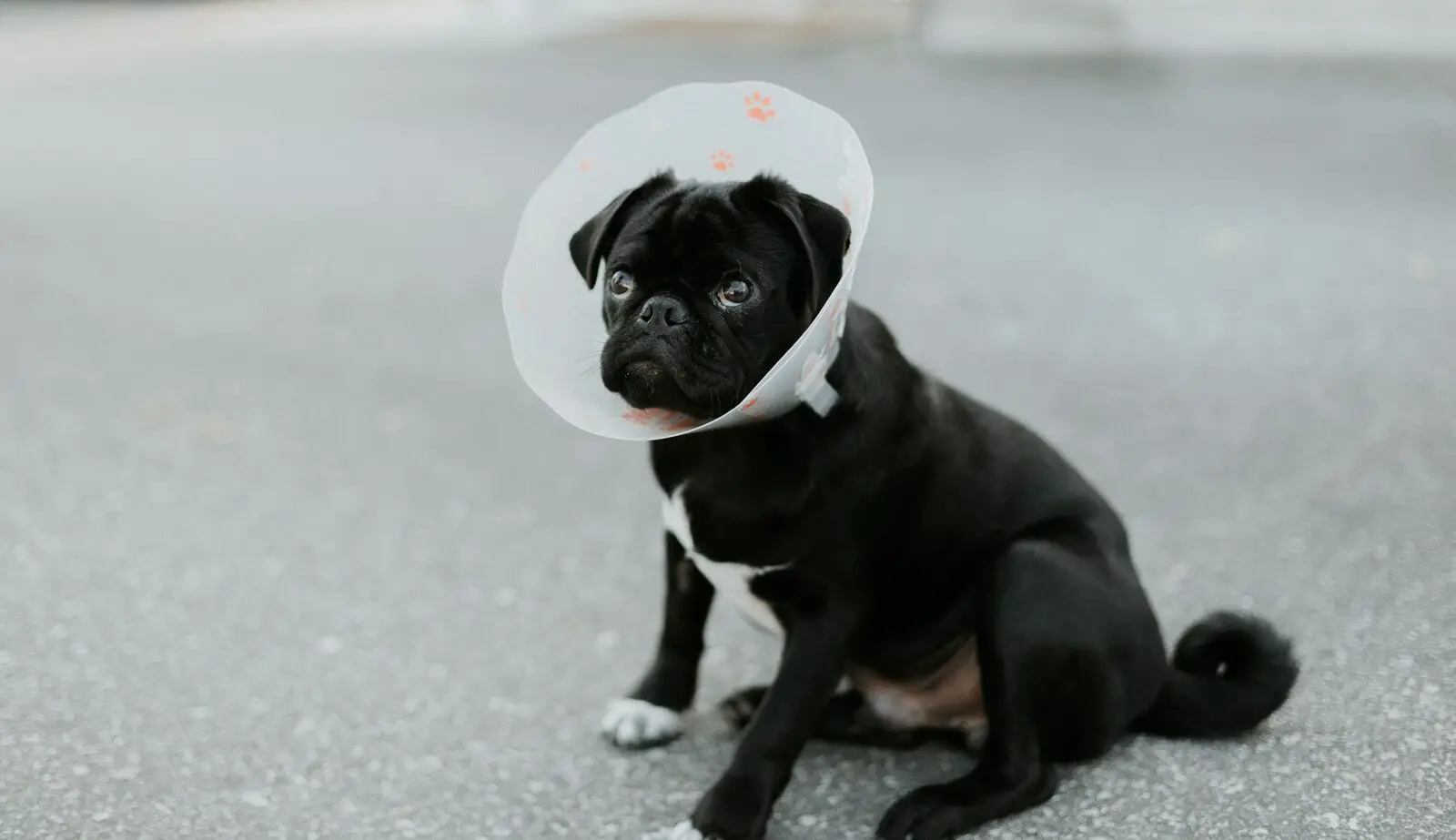If your dog has scratches, scrapes, or other external wounds, you might be wondering if a ointment like Neosporin could expedite the healing process.
Small amounts of Neosporin are generally safe for dogs when prescribed by a veterinarian. However, there are a few things to consider. Below, you’ll find everything you need to know about treating your dog with Neosporin, including potential risks and alternatives to this medication.
What is Neosporin?
Neosporin is the brand name of a common topical antibacterial ointment that contains three antibiotics: Neomycin, Polysporin, and Bacitracin. The combination of these antibiotics is effective against a variety of bacteria.
Neosporin is an over-the-counter medication, meaning it does not require a prescription. This medication is intended for the prevention and treatment of minor skin infections caused by cuts, scratches, or burns. However, it does not work on infections caused by other foreign organisms such as fungi, parasites, or viruses.
There are some issues associated with the use of these medications. Firstly, as some antibiotics become more popular, concerns arise about the increasing bacterial resistance they cause. Aside from resistance, prolonged use of Neomycin may, under certain circumstances, lead to hearing loss. Additionally, Neosporin has not been FDA-approved for use in dogs.
Can Neosporin be used on dogs?
Neosporin is often used to treat minor cuts or skin infections in humans, prompting dog owners to consider using the medication for their dogs. You should not apply over-the-counter medications meant for humans to your dog without consulting a veterinarian first.
While Neosporin is considered safe for minor cuts and scratches in dogs, it is not the best treatment option for your dog. When used in small amounts, Neosporin can prevent further infection and facilitate the healing process. However, remember that Neosporin should only be applied to areas your dog cannot reach with their tongue. Ingesting the medication can be dangerous for pets due to potential gastrointestinal side effects.

If you cannot prevent your dog from licking the affected area, you should replace Neosporin with another medication. Never use Neosporin on your pet’s eyes, ears, or mouth. Avoid applying the ointment extensively or on deep wounds.
The Neosporin website states, “We do not recommend the use of these products on animals.” There are many remedies specifically made for dogs, which are safer and more effective than the triple antibiotic ointment for humans. Therefore, using specialized products for animals is a better idea.
Safety of Neosporin for Dogs
As mentioned earlier, you should consult your veterinarian before administering any medication to your dog. If you are using Neosporin under your vet’s instructions, consider the following:
- Apply the ointment to a small skin area initially to rule out potential allergic reactions. Some dogs may experience contact dermatitis, where the area where the ointment is applied becomes inflamed. Other possible symptoms of an allergic reaction include redness, hives, and itching. If you observe these symptoms in your dog, remove any remnants of the ointment from the skin and discontinue the use of Neosporin. For more severe side effects such as difficulty breathing and facial swelling, take your dog to a veterinarian immediately.
- This medication should never be applied to your dog’s eyes or ears. When applied to wounds on the ears, Neosporin can damage the eardrum and exacerbate existing infections.
- Avoid mixing Neosporin with triple antibiotic eye ointment. Neosporin will only worsen your dog’s eye problems. Instead, seek a veterinary clinic if your dog has eye issues.
- Use the ointment externally only. Neosporin should never be ingested. Otherwise, it can lead to stomach upset, vomiting, diarrhea, and loss of appetite. If your dog has the habit of licking its wounds, you can wrap the affected area with a bandage or an old sock after applying the ointment. An Elizabethan collar can also help.
- Licking the cut or scrape can intensify bacterial growth due to the additional moisture in your dog’s mouth. Try to prevent your furry friend from licking its wound as much as possible.
- Opt for the standard strength of Neosporin and avoid extra-strength varieties containing additional ingredients for pain relief.
How to Use Neosporin on Dogs
Some dogs are so lively and curious that they frequently incur cuts, scratches, and other wounds. Every pet owner needs to know what to do when such accidents happen and be prepared for emergencies that require home care. Experts even recommend keeping a first aid kit for your dog at home.
Sometimes it can be challenging to determine the extent of your pet’s injury or figure out how to treat it. If the damage goes beyond a small cut or scrape, contact a veterinarian. Remember that Neosporin should only be used for minor scrapes, cuts, or insect bites.
Here are all the steps you need to take when you discover that your pet is injured:
- If your pet is bleeding, apply direct pressure to the wound. Applying pressure promotes blood clotting and stops the bleeding. You can use a piece of fabric or a paper towel for this purpose.
- Isolate the wound. Your dog may have more than one injury. Examine the entire body, including the paw pads, for injuries.
- Rinse the wound. This involves flushing the area with warm water and/or saline solution to remove dirt, debris, and possible foreign objects. This can be done with a large syringe, typically included in most dog first aid kits. Avoid touching the affected area with the syringe, as it may cause further irritation. Due to the dog’s fur covering the wound, it’s often challenging to assess the severity of the cut. If, after rinsing, you find it to be a more significant injury, consult your veterinarian before proceeding to the next step.
- Dry the wound before using Neosporin. As always, ask your veterinarian for the correct dosage and instructions before administering the medication. In the case of Neosporin, it is usually best to apply a thin layer of the ointment once to three times daily on your pet’s skin.
- Bandage the wound after applying Neosporin to prevent your dog from licking off the ointment or irritating the area.
Never attempt to heal postoperative wounds with Neosporin! Since antibiotics are typically used during surgery, additional wound care is unnecessary.
Observe your dog’s cut in the following days or until the wound visibly heals. It is advisable to take daily photos of the injury and show them to your veterinarian so they can adjust the treatment plan accordingly.
Side Effects of Neosporin for Dogs
Like all other medications, Neosporin can have unwanted effects on your pet. Therefore, it is essential to closely monitor your four-legged friend during treatment with this medication. Here are some things to watch for:
Allergic reaction:
Although these cases are rare, some dogs may experience an allergic reaction to Neosporin. To avoid this, test the antibacterial ointment on a small area of your dog’s skin to ensure the animal does not react excessively. If you notice that the affected area becomes swollen and red or secretes fluid, consult your veterinarian.
Infections:
Using too much Neosporin can lead to additional infections caused by fungi and other organisms. Excessive application of the ointment can also result in your pet developing a resistant infection.
Irritation and Hearing Loss:
Applying Neosporin to your dog’s eyes can cause irritation. If the ointment enters the animal’s ears, it may lead to hearing loss, infections, and irritation.
Vomiting and Diarrhea:
If your dog accidentally ingests Neosporin, it can cause vomiting and diarrhea. In such a case, contact a veterinarian as soon as possible.
Do not use Neosporin together with other topical medications unless advised by your veterinarian. The best way to avoid these unwanted reactions and side effects is to follow your veterinarian’s instructions precisely.
Alternatives to Neosporin for Dogs
Sometimes, the best treatment is to do nothing. If your dog has minor scratches or bumps on the skin, you can let them heal on their own. A small wound is unlikely to become infected or inflamed. Keep in mind that your pet’s natural healing abilities are much more pronounced than your own. Dogs promote faster wound healing by licking the affected area, as their saliva possesses bactericidal properties. For large wounds and already infected scabs, professional treatment is, of course, necessary. However, people often tend to overreact when it comes to their pets.

If your pet is suffering from a deep wound, you can use Silver Sulfadiazine (SSD) ointment, Bacitracin ointment, and Polysporin ointment, for example. While primarily intended for human use, these ointments are considered safe for pets.
Moreover, there are medications specifically designed for animals available in pet stores and veterinary practices. Ask your veterinarian which option is best for your dog.
Another effective and natural solution is organic virgin coconut oil. Although it is not a medication, coconut oil is known for its potent soothing and protective properties. Additionally, it is entirely safe for your dog and can be ingested without any concern. Lauric acid present in the oil effectively protects the dog against various bacteria, microbes, and fungi. You can confidently use it for minor cuts, wounds, skin rashes, and insect bites.
FAQ
Is it safe to apply Neosporin to a dog’s skin?
Although Neosporin is a human medication, it is considered safe for topical application in dogs. Ensure that only a tiny amount of the ointment is administered and apply it only to body areas where your dog cannot lick it off.
What happens if my dog licks Neosporin?
If your dog accidentally ingests a small amount of Neosporin, it may lead to gastrointestinal issues such as vomiting and diarrhea. Try to cover the wound as much as possible with a bandage to prevent the animal from reaching the medication with its tongue.
How often can I apply Neosporin to my dog?
Typically, a thin layer of Neosporin is applied to the wound once to three times daily.


